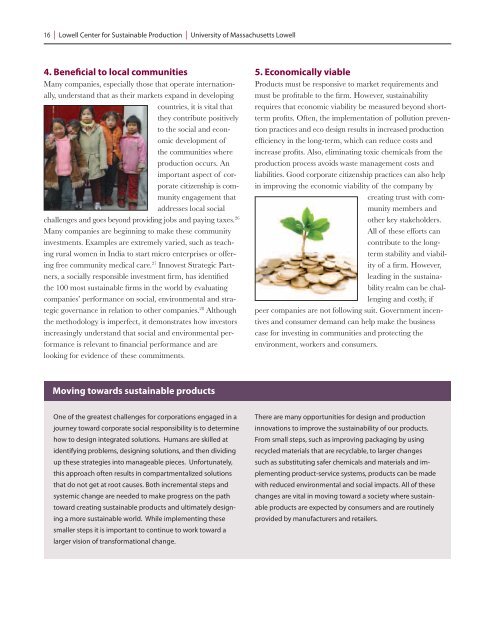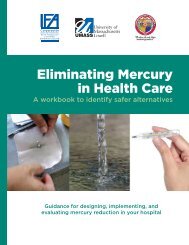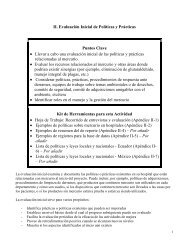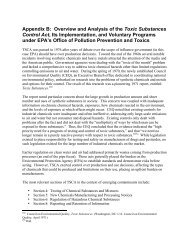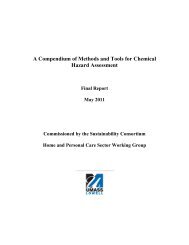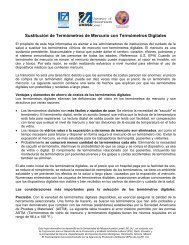Download - The Lowell Center Framework for Sustainable Products
Download - The Lowell Center Framework for Sustainable Products
Download - The Lowell Center Framework for Sustainable Products
You also want an ePaper? Increase the reach of your titles
YUMPU automatically turns print PDFs into web optimized ePapers that Google loves.
16 | <strong>Lowell</strong> <strong>Center</strong> <strong>for</strong> <strong>Sustainable</strong> Production | University of Massachusetts <strong>Lowell</strong><br />
4. Beneficial to local communities<br />
Many companies, especially those that operate internationally,<br />
understand that as their markets expand in developing<br />
countries, it is vital that<br />
they contribute positively<br />
to the social and economic<br />
development of<br />
the communities where<br />
production occurs. An<br />
important aspect of corporate<br />
citizenship is community<br />
engagement that<br />
addresses local social<br />
challenges and goes beyond providing jobs and paying taxes. 26<br />
Many companies are beginning to make these community<br />
investments. Examples are extremely varied, such as teaching<br />
rural women in India to start micro enterprises or offering<br />
free community medical care. 27 Innovest Strategic Partners,<br />
a socially responsible investment firm, has identified<br />
the 100 most sustainable firms in the world by evaluating<br />
companies’ per<strong>for</strong>mance on social, environmental and strategic<br />
governance in relation to other companies. 28 Although<br />
the methodology is imperfect, it demonstrates how investors<br />
increasingly understand that social and environmental per<strong>for</strong>mance<br />
is relevant to financial per<strong>for</strong>mance and are<br />
looking <strong>for</strong> evidence of these commitments.<br />
5. economically viable<br />
<strong>Products</strong> must be responsive to market requirements and<br />
must be profitable to the firm. However, sustainability<br />
requires that economic viability be measured beyond shortterm<br />
profits. Often, the implementation of pollution prevention<br />
practices and eco design results in increased production<br />
efficiency in the long-term, which can reduce costs and<br />
increase profits. Also, eliminating toxic chemicals from the<br />
production process avoids waste management costs and<br />
liabilities. Good corporate citizenship practices can also help<br />
in improving the economic viability of the company by<br />
creating trust with community<br />
members and<br />
other key stakeholders.<br />
All of these ef<strong>for</strong>ts can<br />
contribute to the longterm<br />
stability and viability<br />
of a firm. However,<br />
leading in the sustainability<br />
realm can be challenging<br />
and costly, if<br />
peer companies are not following suit. Government incentives<br />
and consumer demand can help make the business<br />
case <strong>for</strong> investing in communities and protecting the<br />
environment, workers and consumers.<br />
Moving towards sustainable products<br />
One of the greatest challenges <strong>for</strong> corporations engaged in a<br />
journey toward corporate social responsibility is to determine<br />
how to design integrated solutions. Humans are skilled at<br />
identifying problems, designing solutions, and then dividing<br />
up these strategies into manageable pieces. Un<strong>for</strong>tunately,<br />
this approach often results in compartmentalized solutions<br />
that do not get at root causes. Both incremental steps and<br />
systemic change are needed to make progress on the path<br />
toward creating sustainable products and ultimately designing<br />
a more sustainable world. While implementing these<br />
smaller steps it is important to continue to work toward a<br />
larger vision of trans<strong>for</strong>mational change.<br />
<strong>The</strong>re are many opportunities <strong>for</strong> design and production<br />
innovations to improve the sustainability of our products.<br />
From small steps, such as improving packaging by using<br />
recycled materials that are recyclable, to larger changes<br />
such as substituting safer chemicals and materials and implementing<br />
product-service systems, products can be made<br />
with reduced environmental and social impacts. All of these<br />
changes are vital in moving toward a society where sustainable<br />
products are expected by consumers and are routinely<br />
provided by manufacturers and retailers.


